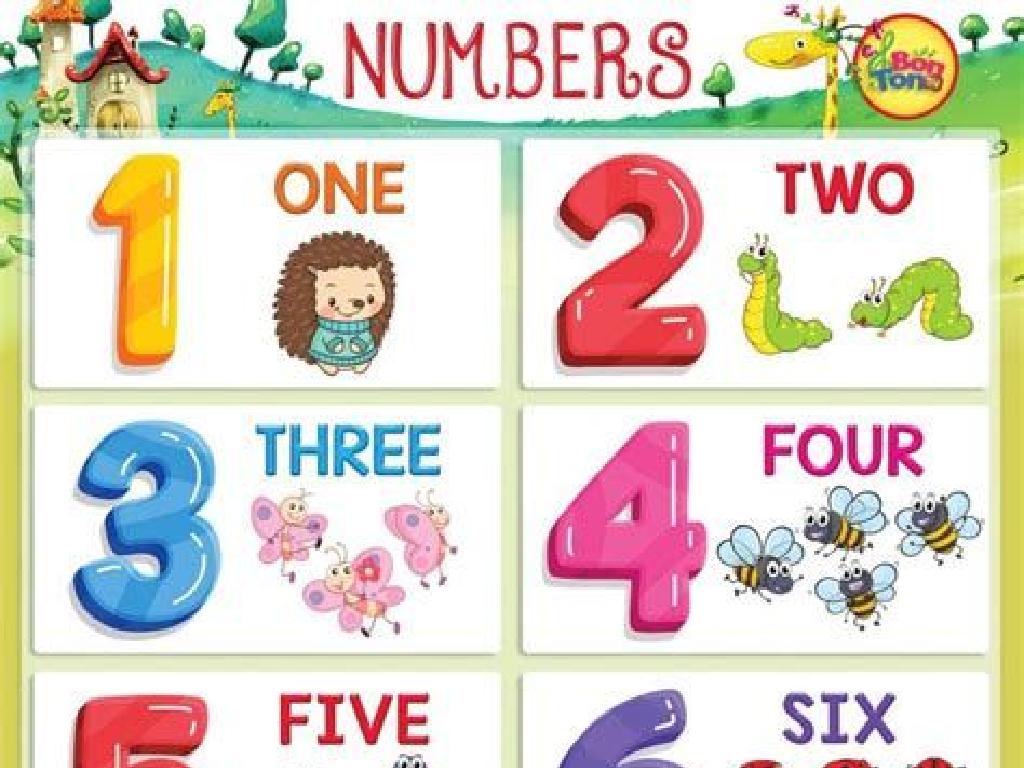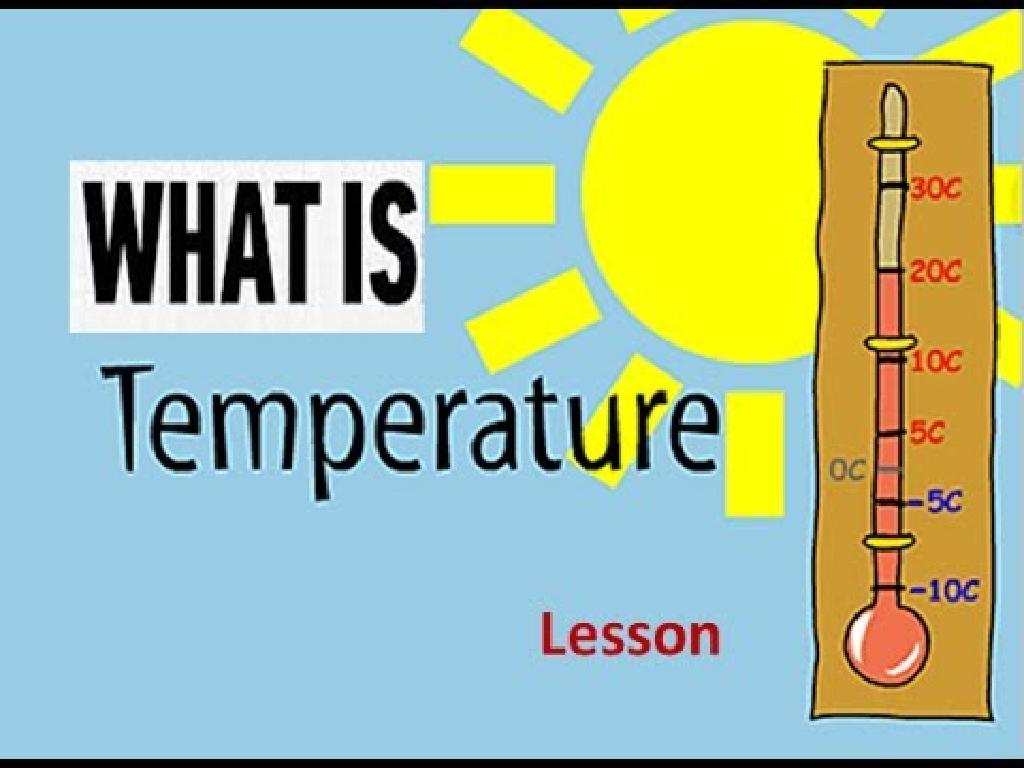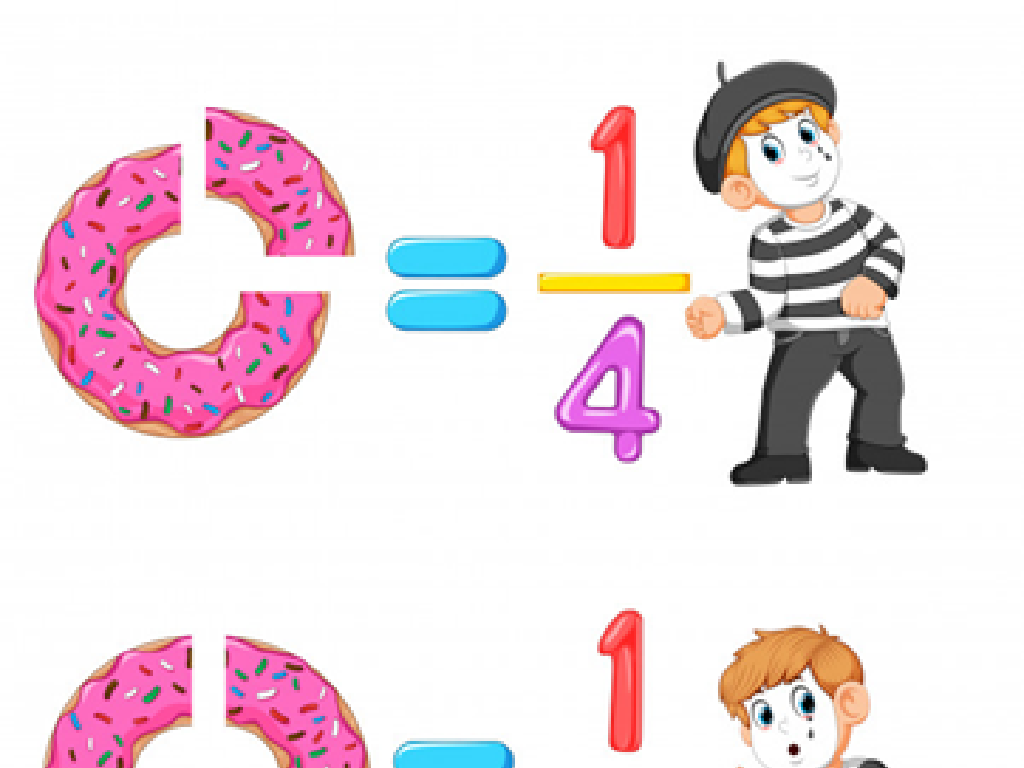Percent Of Change: Find The Original Amount Word Problems
Subject: Math
Grade: Eighth grade
Topic: Percents
Please LOG IN to download the presentation. Access is available to registered users only.
View More Content
Percent of Change: Finding the Original Amount
– Understanding Percent of Change
– Percent of change shows how much a quantity has increased or decreased.
– Formula for Percent of Change
– Use the formula: Percent Change = (Amount of Change / Original Amount) x 100%
– Real-World Applications
– Examples: Discounts, interest rates, population growth.
– Class Activity: Word Problems
|
This slide introduces the concept of percent of change, which is a crucial mathematical tool for understanding how quantities increase or decrease over time. Begin by explaining the concept with simple examples, such as price increase or decrease. Then, present the formula for calculating percent of change and work through an example as a class. Discuss real-life applications where understanding percent of change is essential, such as calculating discounts during shopping, interest rates for savings accounts, or changes in population. Conclude with a class activity where students solve word problems involving percent of change to find the original amount, reinforcing their understanding through practical application.
Understanding Percent of Change
– Define Percent of Change
– The ratio of the amount of change to the original amount, expressed as a percentage.
– Percent Increase vs Decrease
– Increase means the original amount has gone up, while decrease means it has gone down.
– Formulas for Percent Change
– Percent Increase = (Increase/Original Amount) x 100, Percent Decrease = (Decrease/Original Amount) x 100
– Solving Word Problems
– Use formulas to find original amounts in real-life scenarios, like discounts or profit.
|
This slide introduces the concept of percent of change, a fundamental topic in understanding how numbers relate to each other in terms of growth or reduction. It’s crucial to differentiate between percent increase and decrease, as they represent opposite trends. The provided formulas are the key tools for calculating these percentages. To ensure students grasp the concept, present word problems that involve finding the original amount after a percent increase or decrease. This could involve real-world examples such as calculating the original price of an item after a sale or the original population before a percentage increase in growth.
Calculating Percent of Change
– Identify original and new amounts
– Calculate the amount of change
– Subtract original from new to find change
– Apply the Percent of Change formula
– Use formula: (Amount of Change / Original Amount) x 100%
– Solve real-world problems
– Example: If a shirt was $20 and now is $25, what’s the percent of change?
|
This slide introduces the concept of percent of change, which is a crucial part of understanding how numbers relate to each other in real-world scenarios, such as discounts, interest rates, and profit calculations. Start by identifying the original and new amounts in a given problem. Then, calculate the amount of change by subtracting the original amount from the new amount. Next, apply the percent of change formula: (Amount of Change / Original Amount) x 100% to find the percentage increase or decrease. Provide students with practical examples to apply this formula, such as price changes in items or fluctuations in population. Encourage students to practice with word problems to solidify their understanding.
Calculating Percent of Increase
– Original and new price example
– Original price: $50, new price: $65
– Calculate percent of increase
– Percent increase = ((New – Original) / Original) * 100
– Step-by-step solution
– ((65 – 50) / 50) * 100 = 30%
– Significance of percent change
– Understanding percent change helps in comparing costs and analyzing sales data
|
This slide presents a word problem to help students understand the concept of percent of increase. The example provided uses an item that has increased in price from $50 to $65. Students will learn to calculate the percent of increase by using the formula: (New Price – Original Price) / Original Price * 100. This calculation results in a 30% increase. It’s crucial for students to grasp why this is important: understanding percent change is essential in real-world scenarios such as financial literacy, budgeting, and making informed purchasing decisions. Encourage students to practice with additional examples and to consider how percent change can affect their own buying habits.
Calculating Percent of Decrease
– Original population was 25,000
– Decreased population is 20,000
– Calculate percent of decrease
– Subtract the new from the original, divide by original, multiply by 100
– Discuss population change implications
– Effects on economy, services, and community
|
This slide presents a word problem involving the percent of decrease in a town’s population. Start by stating the original population figure. Then, provide the decreased population number. To find the percent of decrease, guide students through the formula: ((original amount – new amount) / original amount) x 100. In this case, ((25,000 – 20,000) / 25,000) x 100, which equals a 20% decrease. After calculating, lead a discussion on the broader implications of such a population change, including potential impacts on local economy, public services, and the overall community. This will help students understand the real-world relevance of the math concept they are learning.
Practice: Finding the Original Amount
– Solve for original amount with percent change
– If a shirt is now $70 after a 30% increase, what was the original price?
– Work through varied problem scenarios
– Tackle problems involving discounts, markups, and more.
– Engage in critical thinking
– Analyze problems, identify what’s given and what’s needed.
– Apply knowledge to new situations
– Use percent formulas in real-world contexts like shopping.
|
This slide is aimed at providing students with practice problems to solidify their understanding of finding the original amount after a percent change. Start with a clear explanation of the formula for finding the original amount. Provide a variety of scenarios, such as discounts, tax additions, or markups, to ensure students can apply the concept in different contexts. Encourage students to think critically about each step and to articulate their reasoning. This will help them grasp the practical applications of percents in everyday life. As they work through the problems, remind them to consider the real-world implications of their mathematical conclusions.
Class Activity: Percent of Change Hunt
– Pair up and find classroom items
– Calculate percent of change
– Determine the increase or decrease in value
– Use provided scenarios
– Scenarios simulate real-life price changes
– Present findings to class
|
This interactive activity is designed to help students apply their knowledge of percent of change to real-world contexts. Students will work in pairs to locate items around the classroom or school and use scenarios provided by the teacher to calculate the percent of change. Scenarios could include situations like discounts during a sale, price increases, or changes in quantities. After calculations, students will present their findings, explaining how they determined the percent of change. For the teacher: Prepare diverse scenarios ahead of time, ensure students understand the formula for percent of change (Percent Change = (New Value – Original Value) / Original Value * 100), and guide them through the process if they struggle. Have at least 4-5 different scenarios ready for variety and to accommodate different student pairs.
Percent of Change: Conclusion & Recap
– Review key percent concepts
Recall formula: Percent Change = (Amount of Change / Original Amount) x 100
– Relevance of percents in life
Discuss practical examples like discounts, interest rates, and tax calculations.
– Engage in Q&A session
– Summarize today’s lesson
Highlight the steps to solve word problems involving original amount.
|
As we wrap up today’s lesson on percent of change, it’s crucial to revisit the main concepts and formulas. Emphasize the practicality of understanding percents in everyday scenarios such as shopping discounts, financial interest, and taxes. Encourage students to ask questions to clarify their doubts and ensure they grasp the methods for finding the original amount in word problems. Summarize the lesson by restating the importance of the percent of change in various real-life situations and how it can be a powerful tool for making informed decisions. Prepare to answer questions that reinforce their understanding and correct any misconceptions.






